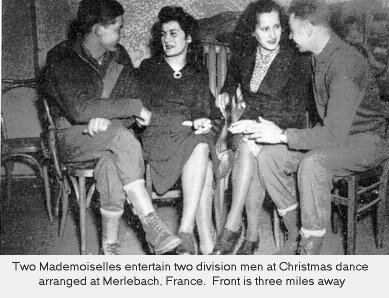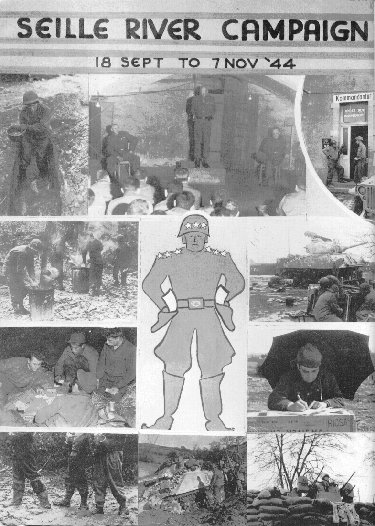Brittany Campaign |
Table of Contents |
Saar Campaign |
|
|
Chapter II |
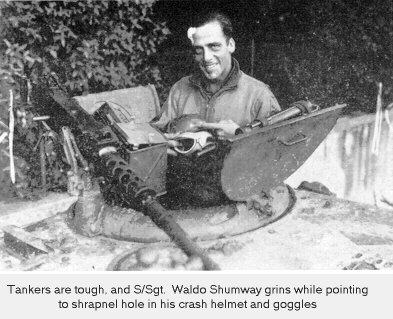 At the close
of the BRITTANY
At the close
of the BRITTANY
campaign the situation of the United States Armies fighting in France was quite fluid. The breakthrough at AVRANCHES had enabled armor to make vast gains in territory and to split the German occupation forces into isolated units. Our forces were pursuing the enemy, linking up, and containing the enemy. The Seventh U. S. Army had launched its invasion from the south and the enemy was retreating into positions before the SIEGFRIED LINE
where lie hoped to hold. On the 4th of September the 6th Armored Division, under VIII Corps' ThirdU.S.Army,was charged with the mission, containing LORIENT and protecting the south flank of the Third and Ninth Armies. The Division front extended 460 miles from the eastern edge of the BREST area to AUXERRE. As new Army units arrived in France and on the BREST PENINSULA, elements of the Division were relieved and pulled into an assembly area near LORRIS. The entire Division never assembled at LORRIS. Before all units arrived, Combat Command B was ordered east and the remainder of the Division expected orders to follow. Thus instead of gaining a chance to complete much-needed maintenance, vehicles which had already seen extensive combat action were about to be used to pursue the enemy. Combat Command B, then at TROYES, received orders from Third U. S. Army to move to an assembly area near NEUFCHATEAU, southwest of NANCY. At this time a very confused situation existed in the vicinity of NANCY where XII Corps had forced crossings of the MOSELLE and SEILLE Rivers. Resistance was very strong, the enemy having apparently determined to hold this area as an outpost line for SIEGFRIED defenses. After the arrival of the 6th Armored, there ensued a series of bitter attacks and counterattacks in which the Division was employed to drive back the enemy and establish a new MLR which was turned over to the 35th and 80th Infantry Divisions to hold for the Corps. Several times the Corps bridgehead was seriously threatened but the 6th Armored drove the Germans back repeatedly over a period of a month and a half, protecting and strengthening the bridgehead in preparation for future thrusts east by the Third U. S. Army. The period was marked by unusually heavy rains which seriously restricted maneuver and employment of armor.
GIRDING FOR ACTION
A change in mission came late the following afternoon, when Combat Command B was relieved from the LUNEVILLE scene by the 6th Cavalry Group and the 695th Tank Destroyer Group. The Armored Command was to assemble in the FORET DE GREMECEY near JALLAUCOURT. The movement was made in three columns over two routes, commencing at 0700A, 22 September. As the south column approached the SEILLE River bridge at MANHOUE, enemy resistance stiffened, ,and held up the armored column with considerable small arms, antitank and bazooka fire. This tenacious action provided a means for the resisting force to withdraw and blow the bridges behind. . In the meantime, early in the morning a strong enemy force of anti-tank guns, tanks and infantry was contacted at ARMAUCOURT by the leading elements of the north column which had forded the SEILLE River at HAN. The enemy was engaged, split, and driven back, the column advancing to LANFROICOURT. At early noon, the reserve column, following the northern route, encountered the Germans again at ARMAUCOURT to which they had returned. Outnumbered 3-1 by the German defenders, the village fell to the small tank force, after three hours of intensive street fighting. With ARMAUCOURT cleared the reserve force proceeded south towards LANFROICOURT.
The combat command continued to attack the withdrawing German troops
moving north along the LEYR-LETRICOURT road. The successful attack
by Combat Command B forced the evacuation of AMANEE HILL and it was occupied
by the 35th Infantry Division doughboys. With AMANEE HILL taken,
Combat Command B was then ordered to capture LEYR, and block any enemy
troop movement to the north or east. Three swift movements succeeded
this order: LEYR was captured, a roadblock was established on the highway
west of ARRAYE-ET-HAN, and a line of defense was consolidated on the high
ground north of ARMAUCOURT. In the two days following three German
counterattacks were repulsed.
MUD,MUD,MUD
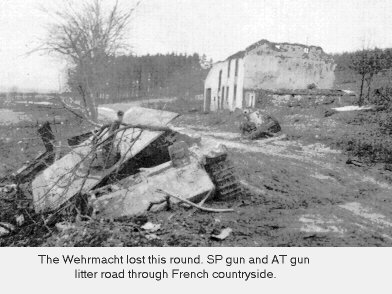 It had
no action and was returned on 30 September. The 35th Division was
ordered to take over our front and the 6th Armored Division, less Combat
Command B and Artillery went into XII Corps reserve west of the SEILLE
River on 25 September in the area near SAULXURES LES NANCY. The Division
Commander ordered that where ever possible, all men in the Division were
to be sheltered indoors as protection from the extremely wet weather.
It had
no action and was returned on 30 September. The 35th Division was
ordered to take over our front and the 6th Armored Division, less Combat
Command B and Artillery went into XII Corps reserve west of the SEILLE
River on 25 September in the area near SAULXURES LES NANCY. The Division
Commander ordered that where ever possible, all men in the Division were
to be sheltered indoors as protection from the extremely wet weather.
When the 35th Division relieved Combat Command A north of GREMECEY WOODS, they did not relieve them in place, but sited their front line in GREMECEY WOODS. The enemy promptly followed up this withdrawal and beginning 26 September initiated an infiltration in force into the woods which reached dangerous proportions and took the form of a full scale artillery supported counterattack on 30 September.
On this date General George S. Patton Jr. with General Manton S. Eddy
visited the Division Command Post just east of NANCY at 1725 and issued
orders through the Corps Commander for the Division, less Combat Command
B, to attack through the 35th Division to restore the Corps MLR.
The Corps Main Line of Resistance at this time was driven in about one
and one-half miles on a two-mile front by a strong counterattack of the
enemy at GREMECEY WOODS, and the enemy threatened to pinch off the whole
Corps bridgehead across the SEILLE River, thereby forcing a retirement
of four miles on a six-mile front. Prior to this order by General
Patton the Corps plan had been to withdraw the 35th through the 6th Armored
and give up the whole Corps bridgehead. General Patton emphatically
stated that he would not give up another foot of ground to the Germans.
NO REST FOR THE WEARY
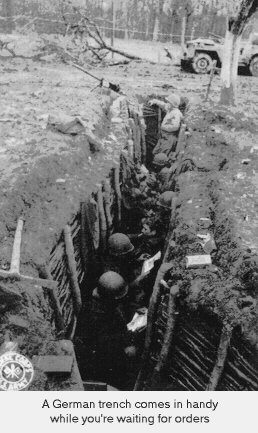 Accordingly,
Combat Connnand A attacked to the north of the woods with two combat teams
abreast and one following, through the units of the 35th Division, on 1
October. By early morning the Command had reached and captured its
objective, the high ground between FRESNES EN SAULNOIS and LEMONCOURT.
Reserve Command attacked east to the south of the woods with two combat
teams abreast, and at about the same time captured its objective, the ridge
north of CHAMBREY. Both Commands were relieved during the afternoon
and evening by the 35th which had followed closely, and then returned to
the assembly area east of NANCY in Corps Reserve.
Accordingly,
Combat Connnand A attacked to the north of the woods with two combat teams
abreast and one following, through the units of the 35th Division, on 1
October. By early morning the Command had reached and captured its
objective, the high ground between FRESNES EN SAULNOIS and LEMONCOURT.
Reserve Command attacked east to the south of the woods with two combat
teams abreast, and at about the same time captured its objective, the ridge
north of CHAMBREY. Both Commands were relieved during the afternoon
and evening by the 35th which had followed closely, and then returned to
the assembly area east of NANCY in Corps Reserve.
Meanwhile, Combat Command B was given the task to support elements of the 80th Infantry Division in an attack on MOIVRON 26 September. Boggy terrain prevented proper maneuver of tanks across country. Enemy infantry in well defended positions, supported by heavy artillery and mortar fire, stopped the 80th Infantry attack and the combat command reverted to its original line north of LEYR.
The next use of the Division in a Corps attack was planned on 4 October. The objective of the attack, beginning 8 October, was to drive the German forces from the western side of the SEILLE River, and to eliminate the enemy from the two hill masses, MT. TOULON and MT. ST. JEAN. The plan: 80th Infantry Division on the left and the 35th Infantry Division on the right, the 6th Armored Division driving north in the center, between the SEILLE River and MT. ST. JEAN. This terrain consisted of a broad plain, studded with villages and with several small forests. The front being too narrow for combat commands abreast, Combat Command B, with two infantry and two tank battalions reinforced, made the Division attack the first day, jumping off in a heavy fog and striking from the center toward the villages on both flanks simultaneously. Within two hours, MOIVRON had been taken against moderate enemy small arms and mortar fire interspersed with light artillery fire. Leaving a covering force to clear the wooded areas, the remaining force swung north-west to JEANDELINCOURT. At 1100, the force had the town surrounded on three sides. By noon the burning town was captured and outposted. Shortly afterwards, 80th Infantry Division troops took over the line established by the Division, and the armored force pushed to the northeast.
The enemy at ARRAYE-ET-HAN was encountered under a very heavy fog. Direct tank, artillery and bazooka fire reduced the village after four hours of impeded observation. Dismounted armored infantry took the village and made contact with the 35th Infantry Division. To the left of ARRAYEET-HAN, additional Combat Command B troops entered AJONCOURT against moderate resistance. Enemy resistance mounted in the wooded areas west of AJONCOURT and it was necessary to call for all available infantry to clear and consolidate the forest.
CHENICOURT and the BOIS DE TRAPPES and LETRICOURT were objectives given Combat Command A, which passed through Combat Command B on the morning of 9 October with one tank and two infantry battalions. Heavy artillery shelling was met by the advancing troops, with the right column receiving the bulk of the fire. By early afternoon, CHENICOURT, source of the artillery and mortar fire, was contained by the right armored column. The village was assaulted and cleared by 1500, 9 October.
Progress was slow, but by noon the forests between LETRICOURT and NOMENY were cleared and a defense line established. Elements of the 80th Infantry Division spreading to the right relieved the 6th Armored Division in the afternoon and evening. The Division, less Artillery and one Combat Command in local reserve, returned to Corps reserve.
Terrain afforded many difficulties in this campaign. The SEILLE
River was unfordable except in one place. A number of small streams
ran into the SEILLE cutting the area into a series of low ridges and stream
bottoms, which were generally soft and difficult for heavy vehicles. .
Heavy rains followed this operation and continued for the balance of the
Fall, so that maneuver was extremely restricted. At 0945 General George
C. Marshall, Chief of Staff, United States Army, visited the Division Command
Post at SAULXURES LES NANCY and congratulated the Division on its excellent
work.
SOME DAYS ARE DULL, THANK GOD
For the first time in many weeks, the greater part of the Division was out of action. Refitting, rest, and maintenance was the order of the day, and for many men came passes into the nearby city of NANCY for a few hours of relaxation, a beer, and then a movie under the auspices of Special Service -- with mud still clinging to their combat boots and a gun over their shoulder.
The beginning of inclement weather characterized by heavy rains made movement by armor practically an impossibility, but plans were now directed toward the offensive which was to open on 8 November and which was to push the enemy back within the Reich. Although most of the Division was in Corps Reserve and ready to support infantry divisions on the line, it was primarily occupied with the preparation of plans for the forthcoming operations. One feature was the placing of "duck bills" on tanks to help movement through mud.
Although no serious action occurred from 10 October until 8 November,
the artillery, reinforced by some tanks and destroyers firing indirect
fire, was in action daily. The stage was now set for the drive. Reconnaissance
of routes of advance to development areas had been made by all commands.
Weapons and vehicles were in a state of readiness. The troops had
been rested and individual equipment had been overhauled. On 7 November
orders were issued by Division to all commands, alerting them for movement
at 0800 the following day.
